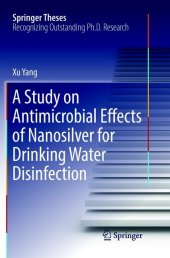 Neuerscheinungen 2018Stand: 2020-02-01 |
Schnellsuche
ISBN/Stichwort/Autor
|
Herderstraße 10
10625 Berlin
Tel.: 030 315 714 16
Fax 030 315 714 14
info@buchspektrum.de |

Xu Yang
A Study on Antimicrobial Effects of Nanosilver for Drinking Water Disinfection
Softcover reprint of the original 1st ed. 2017. 2018. xxii, 71 S. 22 SW-Abb., 4 Farbabb. 235 mm
Verlag/Jahr: SPRINGER, BERLIN; SPRINGER SINGAPORE; SPRINGER 2018
ISBN: 9811097356 (9811097356)
Neue ISBN: 978-9811097355 (9789811097355)
Preis und Lieferzeit: Bitte klicken
This thesis examines the feasibility of using silver nanoparticles (AgNPs) as a viable disinfectant. It explores the opportunities and challenges of using AgNPs as an antimicrobial agent, and includes the latest research findings. It compares three kinds of AgNPs with regard to their antibacterial and antiviral effects; their sustainability in real water matrices; and their antiviral mechanisms. The outcome of this research equips the water industry with a better understanding of the capacity, extent and mechanisms of nanosilver disinfection. It is of interest to graduate students, academics and researchers in the area of nanotechnology and environmental engineering.
TABLE OF CONTENTS
ACKNOWLEDGEMENT I
SUMMARY V
LIST OF TABLES VIII
LIST OF FIGURES IX
LIST OF ABBREVIATIONS XI
CHAPTER 1 INTRODUCTION 1
1.1 DRINKING WATER SAFETY 1
1.2 CURRENT AND EMERGING WATERBORNE PATHOGENS 2
1.2.1 Bacterial pathogens 2
1.2.2 Viral pathogens 3
1.3 SELECTION OF DISINFECTION STRATEGIES 4
1.3.1 Chlorine and related chemicals 5
1.3.2 Ozone 6
1.3.3 Ultraviolet irradiation 7
1.4 SILVER AS ANTIMICROBIAL AGENT 9
1.5 STATE-OF-THE-ART 11
1.6 OBJECTIVES AND RESEARCH SCOPE 14
1.7 ORGANIZATION OF DISSERTATION 17
CHAPTER 2 LITERATURE REVIEW 19
2.1 SYNTHESIS OF SILVER NANOPARTICLES 19
2.1.1 Chemically-Synthesized silver nanoparticles 20
2.1.2 Biologically-synthesized silver nanoparticles 24
2.2 ANTIMICROBIAL EFFECTS OF SILVER NANOPARTICLES 28
2.2.1 Effects of silver nanoparticles´ properties 29
2.2.2 Effects of water matrices 31
2.2.3 Antibacterial and antiviral effects of silver nanoparticles 34
2.3 ANTIMICROBIAL MECHANISM OF SILVER IONS AND SILVER NANOPARTICLES 42
2.3.1 Mechanisms of aqueous silver disinfection 42
2.3.2 Antibacterial mechanisms of silver nanoparticles disinfection 44
2.3.3 Antiviral mechanisms of silver nanoparticles disinfection 49
2.4 CONTINUOUS DISINFECTION SYSTEM WITH SILVER NANOPARTICLES 51
CHAPTER 3 MATERIALS AND METHODS 55
3.1 SILVER NANOPARTICLES 55
3.1.1 Chemically-synthesized silver nanoparticles 55
3.1.2 Biologically-synthesized silver nanoparticles 56
3.1.3 Characterization of silver nanoparticles 56
3.2 MICROORGANISMS CULTIVATION AND ENUMERATION 58
3.2.1 Incubation of E. coli and MS2 coliphage 58
3.2.2 Enumeration of E. coli and MS2 coliphage 58
3.3 DISINFECTION EXPERIMENTS 59
3.4 EFFECTS OF WATER MATRICES 60
3.5 MECHANISM STUDY 61
3.5.1 Mode of action of nanosilver 61
3.5.2 Viral damage 63
3.6 CONTINUOUS FLOW SYSTEM WITH NANOSILVER 66
3.7 DATA INTERPRETATION 69
CHAPTER 4 RESULTS AND DISCUSSION 70
4.1 SELECTION OF DIFFERENT NANOSILVER 70
4.1.1 Characterization of different nanosilver 70
4.1.2 Comparison of effects of different nanosilver against E. coli 73
4.1.3 Comparison of effects of different nanosilver against MS2 coliphage 75
4.1.4 Viral inactivation profile of biologically-synthesized silver nanoparticles 77
4.2 EFFECTS OF WATER MATRICES 78
4.2.1 Effects of chloride 79
4.2.2 Effects of Ca/Mg/ionic strength 80
4.2.3 Effects of TOC 83
4.2.4 Effects of pH 84
4.3 MECHANISM STUDY OF VIRAL INACTIVATION 85
4.3.1 Mode of action of nanosilver 85
4.3.2 Viral damage caused by nanosilver 92
4.4 CONTINUOUS FLOW SYSTEM WITH NANOSILVER 95
4.4.1 Continuous flow system to remove E. coli 95
4.4.2 Continuous flow system to remove MS2 coliphage 99
CHAPTER 5 SUMMARY, CONCLUSIONS AND RECOMMENDATIONS 102
5.1 SUMMARY 102
5.2 CONCLUSIONS 103
5.3 RECOMMENDATIONS 106
LIST OF PUBLICATIONS 108
REFERENCES 109
APPENDIX 121
Xu Yang was conferred his PhD degree by National University of Singapore(NUS) in 2015. Before joining NUS, he gained his B.Sc in Chemistry in Fudan University, P. R. China. He also spent two years as a lab assistant when he was an undergraduate. The experience greatly spurned his interest in nanomaterial and led him to pursue a PhD in the Department of Civil and Environmental Engineering in NUS. Xu Yang is currently working as an engineer in a construction wastewater treatment and environmental consulting firm based in China.


